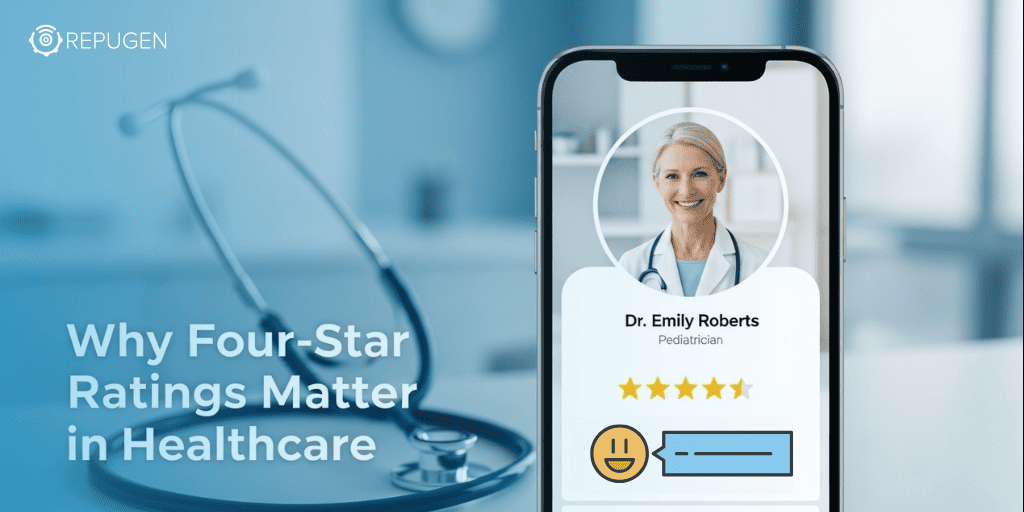
When patients begin their search for a new doctor, they don’t start by calling the front desk. Instead, they open Google, WebMD, or Yelp, type in the provider’s name, and immediately glance at the star rating. In today’s digital-first world, trust begins online, and healthcare ratings are often the deciding factor in whether a patient chooses to schedule an appointment or choose to go elsewhere.
In This Article
A four-star rating has quietly become the invisible line that separates trusted providers from overlooked ones. It’s no longer just a nice-to-have. Patients now see four stars as the bare minimum for credibility. In this blog, we’ll explore why four-star ratings matter so much, what makes them trustworthy, and how providers can protect and grow their online reputation in an increasingly competitive healthcare market.
Over the past few years, one trend has remained remarkably consistent: patients will not settle for anything less than a four-star rating. According to RepuGen’s 2025 Patient Review Survey, nearly 78% of patients only consider providers with at least a four-star rating. That leaves only 22% who are willing to consider doctors rated 3.5 stars or lower.
This expectation isn’t new; it’s a standard that has only grown stronger. Back in 2022, that same 78% of patients set four stars as their threshold. By 2024, the number climbed higher, with 83% of patients insisting on a four-star or higher rating before choosing a provider.
The message is clear: this isn’t a passing trend. Four stars have become the baseline of trust. A practice sitting below that mark may be clinically excellent, but online it risks being invisible.
If patients were only chasing numbers, a 3.8 and a 4.1 wouldn’t feel so different. But what makes star ratings so powerful is the combination of factors that shape patient trust.
Patients don’t just look at the rating; they read the reviews behind it. In fact, 46.49% of patients say that sentiment of reviews matter more than the score itself, compared to 6.03% who focus primarily on the number. A doctor with a glowing set of heartfelt reviews can often overcome a slight dip in star rating.
Patients rarely stop at the first review they see. Instead, they read five to ten of the most recent reviews before forming an opinion. Dozens of old online reviews for doctors and no new ones may raise doubts, while a steady stream of fresh, authentic feedback reassures patients that the experience they’ll get today matches the reputation they’re reading about.
Not all review sites carry the same weight. A strong presence on Google is critical, with nearly 78% of patients checking Google Reviews before making a decision. WebMD (52%) and Yelp (30%) follow as other significant sources. If your four-star reputation isn’t showing up on these platforms, patients may never find you.
Research from Harvard Business School professor Michael Luca found that a one-star increase in ratings can boost revenue by 5–9%. For healthcare providers, that increase can translate into thousands of dollars and dozens of new patients every year.
The takeaway? Four stars is more than just a number. It’s a shorthand for credibility, consistency, and growth.
Reaching a four-star rating is an achievement, but holding on to it requires ongoing effort. Patients notice not only the online reviews for doctors but also how they handle them.
For starters, speed matters. Nearly 38% of consumers expect a response within two to three days of leaving a review. Replying within 24–48 hours shows attentiveness and signals that feedback, good or bad, matters.
But it’s not enough to respond quickly. Empathy counts just as much. When negative reviews surface, acknowledging concerns and inviting the patient to continue the conversation offline can turn a potentially damaging comment into a chance to rebuild trust.
The best responses are personalized, not copy-pasted. Patients can spot generic replies a mile away, and nothing erodes authenticity faster. Providers should tailor responses while staying HIPAA-compliant, showing patients that every voice is valued.
And don’t let reviews sit on third-party sites. A thoughtful, detailed review can become a powerful testimonial. Practices that repurpose their best reviews on websites, brochures, or even social media reinforce their reputation across multiple touchpoints.
Managing a reputation across multiple platforms can feel overwhelming. That’s where technology can step in to simplify the process. RepuGen was built specifically to help healthcare providers develop and protect the trust that comes with a strong four-star reputation.
Here’s how:
Consider the example of Triad Radiology Associates, which partnered with RepuGen. In just months, they boosted their review volume by 415% and raised their average rating from 2.4 to 4.2 stars. That leap not only rebuilt patient confidence but also fueled measurable growth.
When it comes to healthcare, four stars has become the quiet filter patients use to decide who they can trust. Anything less risks being ignored, no matter how skilled the provider or advanced the practice. Patients trust the voices of their peers, and those voices overwhelmingly point toward four stars as the standard.
By combining innovative review management practices with the right tools, providers can transform ratings into lasting reputation and reputation into growth.
Need a review audit? Get a demo today and start building the four-star reputation your patients already expect.
Banner Image Source: Google AI Studio
0 Comment
Your email address will not be published. Required fields are marked *